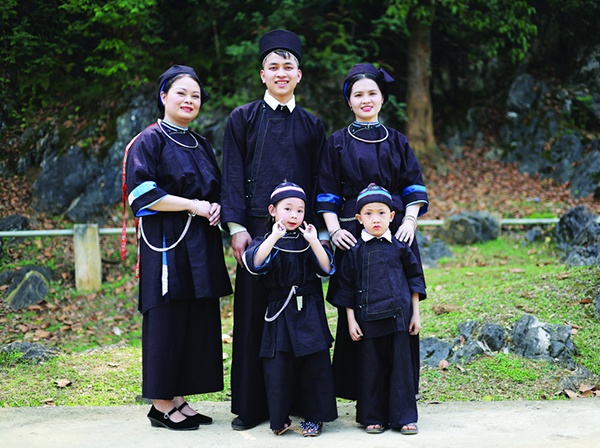The Nùng (pronounced as noong [nuːŋ]) are a Central Tai-speaking ethnic group living primarily in northeastern Vietnam and southwestern Guangxi. The Nùng sometimes call themselves Thổ, which literally means autochthonous (indigenous or native to the land). Their ethnonym is often mingled with that of the Tày as Tày-Nùng. According to the Vietnam census, the population of the Nùng numbered about 856,412 by 1999, 968,800 by 2009, and 1,083,298 by 2019. They are the third largest Tai-speaking group, preceded by the Tày and the Thái (Black Tai, White Tai and Red Tai groups), and sixth overall among national minority groups.
They are closely related to the Tày and the Zhuang. In China, the Nùng together with the Tày are classified as Zhuang people.
Subdivisions
There are several subgroups among the Nùng: Nùng Xuồng, Nùng Giang, Nùng An, Nùng Phàn Slình, Nùng Lòi, Nùng Cháo, Nùng Quý Rỉn, Nùng Dín, Nùng Inh, Nùng Tùng Slìn etc.
Many of the Nùng’s sub-group names correspond to the geographic regions of the Nùng homeland. Hoàng Nam (2008:11) lists the following Nùng subgroups.
Nùng Inh: migrated from Long Ying
Nùng Phàn Slình: migrated from Wan Cheng
Nùng Phàn Slình thua lài
Nùng Phàn Slình cúm cọt
Nùng An: migrated from An Jie
Nùng Dín
Nùng Lòi: migrated from Xia Lei
Nùng Tùng Slìn: migrated from Cong Shan
Nùng Quý Rỉn: migrated from Gui Shun Relationship to the Zhuang and Tày
Relationship to the Zhuang and Tày
The Zhuang, Nùng, and Tày people are a cluster of Tai peoples with very similar customs and dress known as the Rau peoples. In China, the Zhuang are today the largest non-Han Chinese minority with around 14.5 million population in Guangxi Province alone. In Vietnam, as of 1999, there were 933,653 Nùng people and 1,574,822 Tày people. Recently the Tày and Nùng have been referred to as a combined Tày-Nùng minority. However these ethnonyms are a recent phenomenon and did not exist until the modern age. According to Keith Taylor, the Vietnamese terms were “categories of French colonial knowledge” used to differentiate highlanders from lowlanders. The ethnic Zhuang was a product of the “ethnic identification project” pursued in 1950s China.
History
Rise of the Nùng
During the early Song dynasty, the Huang clan was left in charge of the You and Zuo rivers. The Wei had settled on the Song-Viet border.However the power of the Nong clan increased and began to upset Huang supremacy. By the early Song, they ruled over an area known as Temo, which stretched from modern Wenshan Zhuang and Miao Autonomous Prefecture in the west to Jingxi in the east and Guangyuanzhou (Quảng Nguyên, now Cao Bằng province in the south. Emperor Taizong of Song (r. 976-997) bestowed special favors on Nong leadership, acknowledging that they had succeeded the Huang in the Zuo River region. Culture
A hand basket of Nùng people in Vietnam Nationalism
Nationalism
During the Vietnam War, Nùng villages in the Việt Bắc region received very little damage and avoided the devastation of upland communities in the Central Highlands. Although the Democratic Republic of Vietnam supervised state-sponsored migration to upland areas, the north did not experience a massive influx of Kinh Viets, so the ethnic balance around the Nùng Trí Cao temples remained fairly consistent. However the Viet Bac Autonomous Zone in which the Nùng and Tày were most numerous was revoked by Lê Duẩn and the government pursued a policy of forced assimilation of minorities into Vietnamese culture. All education was conducted in the Vietnamese language, traditional customs were discouraged or outlawed, and minority people were moved from their villages into government settlements. At the same time the government created “New Economic Zones” along the Chinese border and in the Central Highlands. Frequently this involved taking the best land in order to resettle thousands of people from the overcrowded lowlands. As tension arose between Vietnam and China in 1975, Hanoi feared the loyalty of the Nùng and the Chinese-Vietnamese. After the Sino-Vietnamese War, support for Nùng Trí Cao could be read as anti-Chinese, as he was mainly seen as a rebel against Chinese authority. Even so, during the 1980s, an estimated 250,000 ethnic Vietnamese were settled in the mountainous regions along the Chinese border, leading to a shortage of food in the region and much suffering.
Culture
Economy
When the Nùng moved into Vietnam from Guangxi during the 12th and 13th centuries, they developed slash-and-burn agriculture and worked on terraced hillsides, tending rice paddies and using water wheels for irrigation. The Nùng engage in similar forms of agriculture today, using their gardens to grow a variety of vegetables, corn, peanuts, and fruits such as tangerines, persimmons, anise and other spices, and bamboo as cash crops. Nùng material culture is similar to other highlanders. They live on higher elevation with houses built with clay on stilts near rivers to avoid flooding. Like the Tày, they are known for silversmithing, weaving, basketry, papermaking, and embroidery. Indigo, which represents faithfulness, is a popular choice of color for clothing. Typical motifs for embroidery are the sun, flowers, and stars.
Customs
Nùng society is patrilineal and grouped into clans denoted by the region in China they came from. In the past, men could marry outside the clan but women could only marry within the clan, however this practice has declined in the present day. Men could have multiple wives.
Language
The Nùng language is part of the Tai language family. Both the Nùng and Tay people used Sawndip script, also known as the Old Zhuang Script, to represent their language, which is closely related to the Zhuang language. Sawndip is a writing system based on Chinese characters to represent their language. In Vietnam, the Tay and Nùng people can no longer read Chinese and write the pronunciation of the characters next to them in the Vietnamese alphabet for their ritual manuscripts.
Religion
Many Nùng practice an indigenous religion with animistic, totemic and shamanic features similarly to other Tai ethnic groups. In addition, Nùng religious practices are heavily influenced by Buddhism and Confucianism. The Nùng worship Quan Âm (Guanyin) as the goddess of compassion and kindness.
Local religious services are led by a village shaman who oversees animal sacrifices and communication with the spiritual world. Nature spirits are known as the phi in Nùng cosmology. Ancestor worship is also practiced.
source:https://en.m.wikipedia.org/wiki/N%C3%B9ng_people



